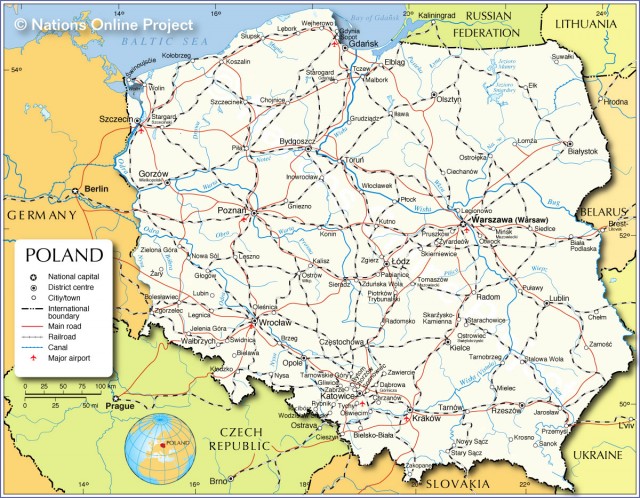Poland
Area 120,728 square mi (312,685 square km)
Population 38.00 million 2014
Capital Warsaw
Highest Point 8,199 ft (2,499 m)
Lowest Point -6.6 ft (-2 m)
GDP $548.0 billion 2014
Primary Natural Resources coal, sulfur, copper, natural gas, silver.
POLAND IS LOCATED in eastern Europe, and is surrounded by the Baltic Sea to the northwest, GERMANY to the west, SLOVAKIA and the CZECH REPUBLIC to the south, and BELARUS, UKRAINE, LITHUANIA, and RUSSIA to the east. The central portion of the country is relatively flat and is an agriculturally driven area. The Vistula River, Poland's longest, flows through this area, and drains into the Baltic Sea. The Sudeten Mountains are located in the west and the Carpathian Mountains run along the south.

About 25 percent of Poland is covered by forests. Wild boar, hare, deer, brown bears, and wildcats can be found among the trees, and numerous storks live in the countryside. The climate is very changeable. A continental climate from the east influences the weather, as well as the maritime climate from the west. Central Poland is the driest area in the country, and the mountain regions receive much rain and snow.
Poland's history can be traced to the reign of Mieszko who converted to Christianity in 966 C.E. During the 14th century, Casimir III the Great built an extensive network of castles and fortifications and one of the first European universities at Krakow. The early Polish state, existed until it was partitioned by Prussia, Russia, and AUSTRIA, in 1795.
After World War I, Poland declared its independence and was under authoritarian rule. On August 23, 1939, the German and Soviet government signed the Ribbentrop-Molotov nonagression pact. This pact secretly separated Poland into Soviet and Nazi controlled zones. On September 1, 1939, the German army marched into the Poland and on September 17, Soviet forces invaded the eastern section of the state. The Soviet troops were eventually overrun by German troops in June 1941.
During the war, exiled Poles created a resistance movement. Some 400,000 Poles fought for the Soviets and 200,000 fought on the western front. However, in 1943, the Soviets broke relations with the Polish government and in July 1944, Soviet troops reentered sections of Poland and created the communist-controlled Polish Committee of National Liberation. The Polish citizens who remained in Poland during World War II were brutally treated by the Nazis. About six million Polish Jews were killed and 2.5 million were deported to Germany, where they faced work at forced-labor camps.
After World War II, the Polish Provisional Government of National Unity was formed. Free elections were planned two years later but never occurred. The Communist Party had begun to enforce its rule over the citizens. During 1956, the communist hold over Polish politics seemed to lessen its grip as a period of liberalization occurred under First Secretary Wladyslaw Gomulka. However, this was short-lived, when in 1968, a series of student demonstrations were suppressed. In 1970, many Polish citizens became upset with the living and working conditions in the country, and Gomulka was replaced with Edward Gierek.
During the first half of the 1970s, Poland's economic growth rate was one of the highest in the world. Western credit was infused into the economy, but much of the capital was misspent in the centrally planned economy. As the decade progressed, the country's debt became a major problem and the economic growth halted.
By July 1980, the foreign debt was more than $20 billion, and workers became incensed over the rising prices. Throughout the summer, a series of strikes took place across the nation. On August 31, 1980, workers at a shipyard in Gdansk, led by Lech Walesa, signed an agreement, which guaranteed the right for the workers to create an independent trade union. Other agreements were created as the Solidarity movement grew. Ten million Polish citizens, including 1 million Communist Party members, joined the Solidarity trade union.
As discontent grew with the corruption in the government, Gierek was replaced as first secretary by Stanislaw Kania. The Soviet military also moved along the Polish border, and in December 1981, after the Polish regime declared martial law, the Red Army moved into Poland to eliminate the union. Many of the union leaders, including Walesa, were taken prisoner, and Western countries, including the United States, imposed economic sanctions on the Polish Communist regime and Soviet Union.
One year later, martial law was suspended, and for the next two years, prisoners were slowly released. However, the seeds of the Solidarity movement could not be eliminated, and by 1988, strikes once again occurred throughout the country. As the Soviet and communist influence in Eastern Europe was dwindling with a surge of democracy, a new government led by noncommunists was created in 1989.
The Polish government changed its economy from being centrally planned to free-market-based. In May 1990, the local elections were free, and the Solidarity Citizens' Committee was successful in winning a majority. In December 1990, Lech Walesa became the first democratically elected president in the history of Poland.
Throughout the 1990s, Poland made strides in achieving a democratic government and a market economy. In 1995, Walesa was defeated by the Democratic Left Alliance candidate, Aleksander Kwasniewski. After a brief departure from the presidency between 1995 and 1997, Kwasniewski regained the presidency and was in power as of 2005. The economy grew rapidly into the mid-1990s with an economic “shock therapy” program but then slowed, which resulted in a rise of unemployment. Throughout its transition process, the United States and other Western nations have reduced Poland's foreign debt and provided economic aid. Trade barriers have also been lowered.
The outlook for Poland seems extremely bright. As the country joins the EUROPEAN UNION, the economy continues to make strides. After hundreds of tumultuous years, Poland seems destined for economic and political success in the 21st century.